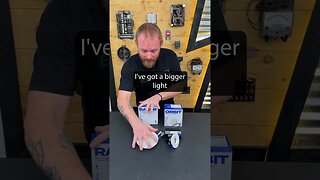Premium Only Content

What to Do on a Jobsite Without a Plan
Not all of us are fortunate enough to have a job with an actual valid work plan. Or sometimes, we fail to make a good plan ourselves! In the latest episode of Electrician U, Dustin talks about what to do on a jobsite when you don’t have a plan and not sure where to really start.
🤘⚡️MEMBERSHIP⚡️🤘
JOIN ELECTRICIAN U - become a member and get:
FREE Continuing Education every year
FREE Practice Exams
FREE Monthly Video Courses
FREE Weekly Live Instructor-Led Classes
FREE Monthly Educational Newsletter
Premium Members-Only Content
Private Discord Channel
Monthly Members-Only Discord Chats
Sign up here --- https://www.electricianu.com/electrician-u-membership/
🎧🎹MUSIC AND VIDEO:🎹🎧
https://www.facebook.com/descantmv
🎬✍️ART AND ILLUSTRATION:✍️🎬
https://www.daverussoart.com
The one thing that you should consider is the NEC. It honestly has the information you need to be able to not only wire your project correctly, but WHERE to place things and HOW MANY. Something else to consider, as far as the NEC goes, is that the Code deals in minimums and maximums. You can always do MORE than the Code requires, but not less. Another good way to look at the building is “what would I do if I lived here”? That is at least a place to start!
So, for the house that Dustin is wiring in the video, the place to start would be where the power comes in, or the service. How big is it and where is it located? From there, know that you will have to have a panel to distribute the power throughout the jobsite. Again, how big is it and where is it located? As a side note, on some jobs, these two pieces will already be in place (in the case of remodels) and may not require anything more than adding circuitry to the existing panel.
The next logical place to figure out would be the receptacle layout. Article 210 of the NEC governs receptacles in dwelling units. In essence, 6 feet from a doorway and then receptacles need to be placed every 12 feet (or within 12 feet from the previous one) along the walls. There are a few exceptions that other sections will need to be referenced such as in kitchens, bathrooms, hallways, exterior locations, and a few other locations. If plans are non-existent or sketchy, you can always look around the job and make some assumptions or educated guesses. You should be able to tell where the kitchen is and be able to locate where power will be needed for the garbage disposal and dishwasher. You can tell where the bathrooms will be located so you can place your GFCI and switches. These items are easy to locate once you know what you are looking for. Water lines and drain lines are dead giveaways as to what will be placed where!
Lighting is a bit of a different animal than standard power and will require input from the owner or GC on the project. But even then, there are things that can be assumed. Can lights should be placed in the CENTER of the hallways. Generally, fixtures are placed in the CENTER of bedrooms with switches located adjacent to the doorway opposite of the doors actual swing. Remember, if there are multiple ways into the same room, you may have to consider installing 3-way or 4-way switching depending on the quantity of entrances into the room.
Another place to look for info is from the other subcontractors. Ask the AV (audio visual) contractor where the TV’s will be placed and what height should you place the power device. Also, another good question to ask, especially in todays era, is “where would the AV rack (if there is one) be placed” so you can provide the necessary items for that.
So, using the NEC as a reference and then logically walking thru the job and placing things where you would think is optimum, is a great place to start if you don’t have an actual plan. Ask questions of the other subs and collaborate. Without an actual plan, if you approach it that way, you can at least get started with your work and will usually allow you to rough in the bulk of the project.
We hope this has been helpful in understanding how to approach a project without an actual work plan in place. Is there a topic you would like to see discussed? Leave a comment in the section below and let us know. Please continue to follow Dustin and Electrician U as we are constantly adding new content to help our followers become the best electricians they can be!
-
 0:50
0:50
Electrician U
1 year agoWhat Are Lumens?
12.8K4 -
 1:05:28
1:05:28
Flyover Conservatives
20 hours agoUkraine’s Dirty Secret: The Christian Persecution No One Wants to Talk About - Alex Newman | FOC Show
42K17 -
 2:00:20
2:00:20
Glenn Greenwald
12 hours agoThe View from Moscow: Key Russian Analyst Aleksandr Dugin on Trump, Ukraine, Russia, and Globalism | SYSTEM UPDATE #414
113K59 -
 1:10:55
1:10:55
Donald Trump Jr.
9 hours agoBREAKING NEWS: My Father Revokes Biden-Maduro Oil License, LIVE with Maria Corina Machado | Triggered Ep.220
191K195 -
 1:25:29
1:25:29
Sarah Westall
8 hours agoX-Files True History, Project Blue Beam, Cabal Faction War w/ Former FBI Agent John DeSouza
76.4K12 -
 7:03:49
7:03:49
Dr Disrespect
15 hours ago🔴LIVE - DR DISRESPECT - NEW PC VS. DELTA FORCE - MAX SETTINGS
163K27 -
 49:04
49:04
Lights, Camera, Barstool
1 day agoIs The Monkey The Worst Movie Of The Year?? + Amazon Gets Bond
69.9K4 -
 24:19
24:19
Adam Carolla
1 day agoDiddy’s Legal Drama Escalates, Smuggler Caught Hiding WHAT? + Philly Eagles & The White House #news
116K19 -
 10:12
10:12
Mike Rowe
2 days agoClint Hill: What A Man. What A Life. | The Way I Heard It with Mike Rowe
120K17 -
 1:31:52
1:31:52
Redacted News
11 hours agoBOMBSHELL! This is war! FBI whistleblowers reveal Epstein files being destroyed? | Redacted News
190K366